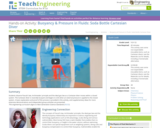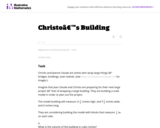
In this video tutorial, determine the volume of a rectangular prism and assess learning with a quiz. [4:21]
- Subject:
- Mathematics
- Material Type:
- Audio/Video
- Provider:
- Sophia Learning
- Date Added:
- 12/01/2023

In this video tutorial, determine the volume of a rectangular prism and assess learning with a quiz. [4:21]

After completing the associated lesson and its first associated activity, students are familiar with the 20 major bones in the human body knowing their locations and relative densities. When those bones break, lose their densities or are destroyed, we look to biomedical engineers to provide replacements. In this activity, student pairs are challenged to choose materials and create prototypes that could replace specific bones. They follow the steps of the engineering design process, researching, brainstorming, prototyping and testing to find bone replacement solutions. Specifically, they focus on identifying substances that when combined into a creative design might provide the same density (and thus strength and support) as their natural counterparts. After iterations to improve their designs, they present their bone alternative solutions to the rest of the class. They refer to the measured and calculated densities for fabricated human bones calculated in the previous activity, and conduct Internet research to learn the densities of given fabrication materials (or measure/calculate those densities if not found online).

Estimate the volume you get when you fill 3D shapes with candy. This video focuses on estimating volume using nonstandard units, using the volume equation to get a more reliable estimate and checking your estimate by counting the nonstandard units.

This short video and interactive assessment activity is designed to teach second graders about capacity comparison problems with illustrations - word problems.

This short video and interactive assessment activity is designed to teach third graders an overview of capacity IIi (metric units).

This short video and interactive assessment activity is designed to teach second graders about capacity problems with illustrations - word problems.

Watch a software developer explain how a love of math, science, and the creative process led him to pursue a career in information systems.

Students observe Pascal's law, Archimedes' principle and the ideal gas law as a Cartesian diver moves within a closed system. The Cartesian diver is neutrally buoyant and begins to sink when an external pressure is applied to the closed system. A basic explanation and proof of this process is provided in this activity, and supplementary ideas for more extensive demonstrations and independent group activities are presented.

The purpose of this task is to use geometric and algebraic reasoning to model a real-life scenario. In particular, students are in several places (implicitly or explicitly) to reason as to when making approximations is reasonable and when to round, when to use equalities vs. inequalities, and the choice of units to work with (e.g., mm vs. cm).

This short video and interactive assessment activity is designed to teach fifth graders about challenging multi-step money problems.

This short video and interactive assessment activity is designed to teach fifth graders about choosing the correct unit with liters or milliliters.

This task is primarily about volume and surface area, although it also gives students an early look at converting between measurements in scale models and the real objects they correspond to.

This short video and interactive assessment activity is designed to teach fifth graders about coins and bills.

This short video and interactive assessment activity is designed to teach second graders about making observations about capacity (metric units).

This short video and interactive assessment activity is designed to teach second graders about comparing the capacity by formula in quarts, pints and cups.

This short video and interactive assessment activity is designed to teach second graders about comparing gallons and quarts by pictures.

This short video and interactive assessment activity is designed to teach fifth graders about multiple object lengths (english units).

This short video and interactive assessment activity is designed to teach second graders about comparing gallons, pints, and quarts by formula.

This short video and interactive assessment activity is designed to teach second graders about comparing capacity with pictures (english units).